Instruction
6 reasons why golfers struggle with back pain: Part 2

This article is co-written with Marnus Marais. Since 2011, Marnus has worked with some of the world’s best players on both the PGA Tour and European Tour, helping them to maintain optimal health and peak physical performance. His current stable of players includes Dustin Johnson, Patrick Cantlay, and Louis Oosthuizen, amongst others.
You can find more information on Marnus and his work at marnusmarais.com
Following on from Part 1 of this article, we examine reasons 4, 5 and 6 for why golfers suffer from low back pain.
Reason 4: Weak Core Muscles
Before we make start making exercise recommendations for this complicated area of the body, it’s worth asking—what is the core exactly? There is considerable debate about this often misunderstood region. Back pain expert Professor Stuart McGill, explains it as follows:
‘The core is composed of the lumbar spine, the muscles of the abdominal wall, the back extensors, and quadratus lumborum. Also included are the multijoint muscles, namely, latissimus dorsi and psoas that pass through the core, linking it to the pelvis, legs, shoulders, and arms. Given the anatomic and biomechanical synergy with the pelvis, the gluteal muscles may also be considered to be essential components as primary power generators’
In a golf context, there is a common myth that the core muscles are our main source of power in the swing. In reality, the main role of the core is to provide stiffness and stable support for force/power transfer from our legs to our upper body
If we can create stiffness and stability in our core, we can help protect our spine and surrounding structures from unnecessary strain whilst also improving swing efficiency—pretty sweet combo!
Due to a combination of perpetual sitting, poor posture and other detrimental lifestyle factors, our cores tend to lose this ability to provide stiffness and stability. We can combat and correct this with a solid core conditioning program. Below are examples of some of our favorite exercises.


Dead Bug with Fitball – the combination of squeezing the fitball whilst extending arm and leg delivers all sorts of great stimulus for the core muscles.
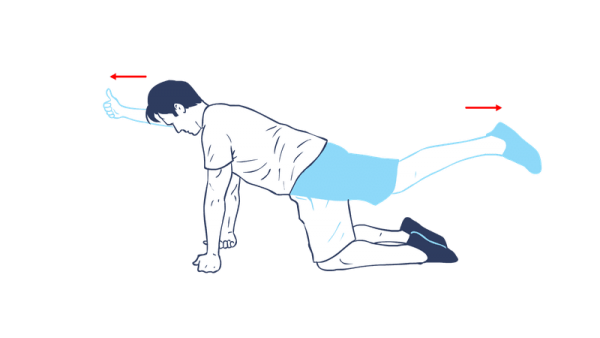
Bird Dog – great for glute, core and back strength
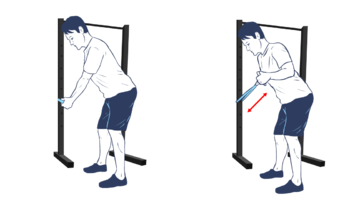
Pallof Press – fantastic anti-rotation exercise. Good for strengthening the core whilst using the ground efficiently
Reason 5 – Not Warming up Properly/Not Warming up at All!
As we’ve explained above, mechanical back pain arises from too much stress and strain placed on the back. During the game of golf, we treat our spines terribly—expecting them to twist, turn and contort with the aim of producing decent golf shots!
If we don’t prepare our bodies for an activity like golf and just go out cold, we significantly increase the chances for strain and stress being placed on the lumbar area.
I’m sure many of you have had the experience of throwing a ball or a stick hard without warming up, and received a nasty sharp pain in your shoulder. Now, if you were to warm up before doing that; stretching your shoulder, making a few practice throws etc, you’d likely avoid strain altogether. Same goes for the low back and the golf swing – without a decent warm-up, there’s every possibility of a strain when trying to rip driver down the first!
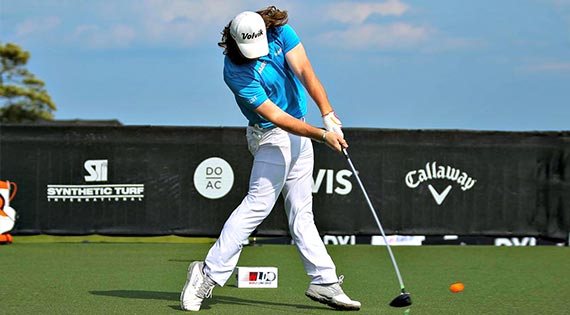
By incorporating a warm-up into your pre-golf routine, you can significantly reduce the risk for injury AND help avoid that card wrecking double-double start! As a side bonus, warming up regularly can help your general health, fitness, and wellbeing too.
We know that most amateurs don’t warm up; a study done by Fradkin et. al showed that around 70 percent of amateur golfers seldom warm-up, with only 3.8% reporting warming up on every occasion!
A decent warm isn’t hard and doesn’t have to take ages to complete; research shows that a warm-up of 10-20 minutes is sufficient. In the video below, Marnus gives a thorough guide to a solid warm up sequence.
Reason 6 – Swing Faults
Let’s not forget the golf swing. One of the most common reasons I see golfers struggle with low back pain is that they are unable to “get to their lead side” and “get stuck” on the downswing. This causes the aforementioned excessive side bend and rotation from the low back, which we need to avoid!

“Getting stuck” on the trail side
Now we aren’t golf coaches and therefore don’t deliver swing advice. However, there are some fundamental movement patterns that most golfers could benefit from practicing. In the videos below, one of our favorite body orientated swing coaches, Richard Woodhouse, is using one of our favorite training tools, the GravityFit TPro, to help teach an efficient movement pattern. The aim is to develop a strong connection between arms and body, using the hips and thorax to rotate, thereby helping to avoid “getting stuck.”
Summary
The absolute best practice for a healthy golfing lower back is working with a golf swing instructor and also a health/fitness professional that understands the body and swing connection. As a team, they would be able to identify and improve your individual swing faults, movement pattern dysfunctions, range of motion deficiencies, muscle weakness, imbalances, and alignment issues.
If you don’t have access to such expertise locally, you may want to check out the online services offered by Marnus and Nick here:
Marnus – https://www.marnusmarais.com
Nick – https://www.golffitpro.net/
- LIKE50
- LEGIT4
- WOW0
- LOL0
- IDHT0
- FLOP3
- OB2
- SHANK2
Instruction
Clement: Laid-off or perfect fade? Across-the-line or perfect draw?

Some call the image on the left laid off, but if you are hitting a fade, this could be a perfect backswing for it! Same for across the line for a draw! Stop racking your brain with perceived mistakes and simply match backswing to shot shape!
- LIKE0
- LEGIT0
- WOW0
- LOL0
- IDHT0
- FLOP0
- OB0
- SHANK1
Instruction
The Wedge Guy: The easiest-to-learn golf basic

My golf learning began with this simple fact – if you don’t have a fundamentally sound hold on the golf club, it is practically impossible for your body to execute a fundamentally sound golf swing. I’m still a big believer that the golf swing is much easier to execute if you begin with the proper hold on the club.
As you might imagine, I come into contact with hundreds of golfers of all skill levels. And it is very rare to see a good player with a bad hold on the golf club. There are some exceptions, for sure, but they are very few and very far between, and they typically have beat so many balls with their poor grip that they’ve found a way to work around it.
The reality of biophysics is that the body moves only in certain ways – and the particulars of the way you hold the golf club can totally prevent a sound swing motion that allows the club to release properly through the impact zone. The wonderful thing is that anyone can learn how to put a fundamentally sound hold on the golf club, and you can practice it anywhere your hands are not otherwise engaged, like watching TV or just sitting and relaxing.
Whether you prefer an overlap, interlock or full-finger (not baseball!) grip on the club, the same fundamentals apply. Here are the major grip faults I see most often, in the order of the frequency:
Mis-aligned hands
By this I mean that the palms of the two hands are not parallel to each other. Too many golfers have a weak left hand and strong right, or vice versa. The easiest way to learn how to hold the club with your palms aligned properly is to grip a plain wooden ruler or yardstick. It forces the hands to align properly and shows you how that feels. If you grip and re-grip a yardstick several times, then grip a club, you’ll see that the learning curve is almost immediate.
The position of the grip in the upper/left hand
I also observe many golfers who have the butt of the grip too far into the heel pad of the upper hand (the left hand for right-handed players). It’s amazing how much easier it is to release the club through the ball if even 1/4-1/2″ of the butt is beyond the left heel pad. Try this yourself to see what I mean. Swing the club freely with just your left hand and notice the difference in its release from when you hold it at the end of the grip, versus gripping down even a half inch.
To help you really understand how this works, go to the range and hit shots with your five-iron gripped down a full inch to make the club the same length as your seven-iron. You will probably see an amazing shot shape difference, and likely not see as much distance loss as you would expect.
Too much lower (right) hand on the club
It seems like almost all golfers of 8-10 handicap or higher have the club too far into the palm of the lower hand, because that feels “good” if you are trying to control the path of the clubhead to the ball. But the golf swing is not an effort to hit at the ball – it is a swing of the club. The proper hold on the club has the grip underneath the pad at the base of the fingers. This will likely feel “weak” to you — like you cannot control the club like that. EXACTLY. You should not be trying to control the club with your lower/master hand.
Gripping too tightly
Nearly all golfers hold the club too tightly, which tenses up the forearms and prevents a proper release of the club through impact. In order for the club to move back and through properly, you must feel that the club is controlled by the last three fingers of the upper hand, and the middle two fingers of the lower hand. If you engage your thumbs and forefingers in “holding” the club, the result will almost always be a grip that is too tight. Try this for yourself. Hold the club in your upper hand only, and squeeze firmly with just the last three fingers, with the forefinger and thumb off the club entirely. You have good control, but your forearms are not tense. Then begin to squeeze down with your thumb and forefinger and observe the tensing of the entire forearm. This is the way we are made, so the key to preventing tenseness in the arms is to hold the club very lightly with the “pinchers” — the thumbs and forefingers.
So, those are what I believe are the four fundamentals of a good grip. Anyone can learn them in their home or office very quickly. There is no easier way to improve your ball striking consistency and add distance than giving more attention to the way you hold the golf club.
More from the Wedge Guy
- The Wedge Guy: Golf mastery begins with your wedge game
- The Wedge Guy: Why golf is 20 times harder than brain surgery
- The Wedge Guy: Musings on the golf ball rollback
- LIKE87
- LEGIT13
- WOW6
- LOL1
- IDHT0
- FLOP4
- OB1
- SHANK8
Instruction
Clement: Stop ripping off your swing with this drill!

Not the dreaded headcover under the armpit drill! As if your body is defective and can’t function by itself! Have you seen how incredible the human machine is with all the incredible feats of agility all kinds of athletes are accomplishing? You think your body is so defective (the good Lord is laughing his head off at you) that it needs a headcover tucked under the armpit so you can swing like T-Rex?
- LIKE0
- LEGIT2
- WOW2
- LOL0
- IDHT0
- FLOP0
- OB0
- SHANK2
-

 19th Hole2 weeks ago
19th Hole2 weeks agoDave Portnoy places monstrous outright bet for the 2024 Masters
-

 19th Hole5 days ago
19th Hole5 days agoJustin Thomas on the equipment choice of Scottie Scheffler that he thinks is ‘weird’
-

 19th Hole3 weeks ago
19th Hole3 weeks agoTiger Woods arrives at 2024 Masters equipped with a putter that may surprise you
-

 19th Hole4 days ago
19th Hole4 days ago‘Absolutely crazy’ – Major champ lays into Patrick Cantlay over his decision on final hole of RBC Heritage
-

 19th Hole2 weeks ago
19th Hole2 weeks agoTwo star names reportedly blanked Jon Rahm all week at the Masters
-

 19th Hole2 weeks ago
19th Hole2 weeks agoReport: LIV Golf identifies latest star name they hope to sign to breakaway tour
-

 19th Hole2 weeks ago
19th Hole2 weeks agoNeal Shipley presser ends in awkward fashion after reporter claims Tiger handed him note on 8th fairway
-

 19th Hole1 week ago
19th Hole1 week agoBrandel Chamblee has ‘no doubt’ who started the McIlroy/LIV rumor and why











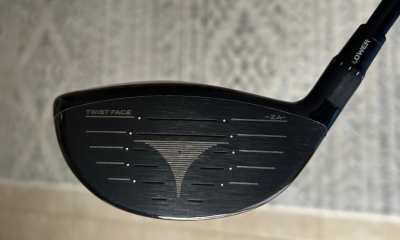

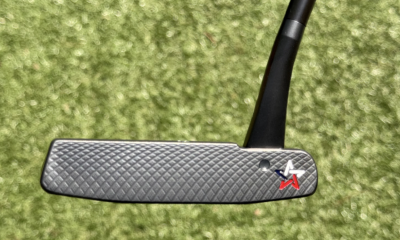










F
Nov 17, 2019 at 1:00 pm
Reason 1: the Modern, Athletic, NFL-MLB type uptight physical muscle swing for the short-term explosive career, a swing that has too much force. The other swing is the torque swing like Couples that has too much hip slide paired with the elbow crushed into the ribs.
That’s why a hunched back and a squat is the swing for a lifetime for no back injuries.